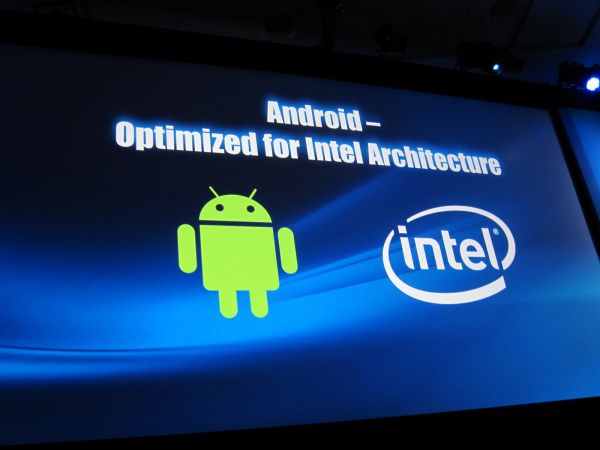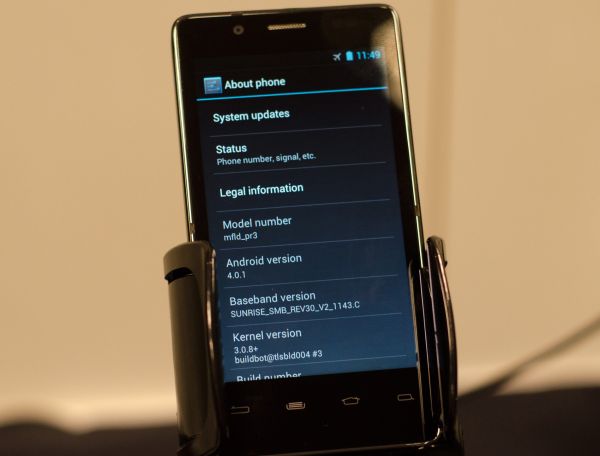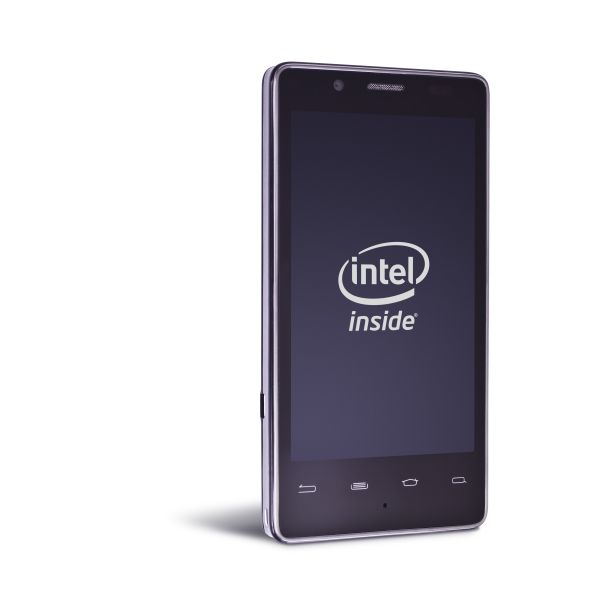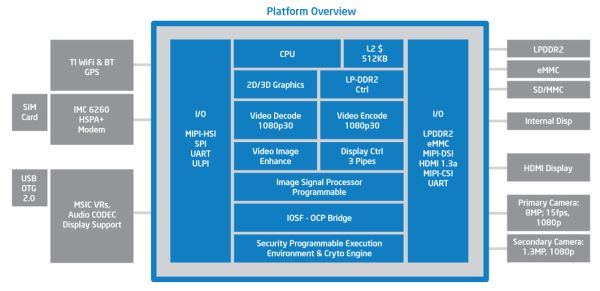Intel's Medfield & Atom Z2460 Arrive for Smartphones: It's Finally Here
by Anand Lal Shimpi on January 10, 2012 8:00 PM ESTWhat's Different This Time Around: Google & A Sweet Reference Platform
Intel has been talking about getting into smartphones for a couple of years now, but thus far it hasn't been able to secure a single design or partnership that that resulted in a product actually coming to market. This time around, things are different. The major change? Focus, and Google.
Intel originally had ambitions of enabling its own mobile OS with the help of Nokia (Moblin/MeeGo). Intel also wanted to support Android as well, however its attention was clearly more focused on the Moblin/MeeGo effort. Similar to the wake up call that pushed NVIDIA to focus exclusively on Android, Intel has now done the same.
At IDF last year Intel and Google announced a partnership and the intention to bring all future versions of Android, starting with Gingerbread, to x86. Since then Intel has ramped up the software engineering engine, going into the Android source code (Gingerbread, Honeycomb and now ICS) and fixing bugs. Intel's goal is to deliver the most stable version of Android as a result of its efforts. Intel is also submitting its changes upstream to the AOSP, which should help improve the Android experience even on ARM platforms.
Under the leadership of Mike Bell (formerly of Apple and Palm), Intel has also created an extremely polished Medfield reference design. This is the same design shown off at IDF last year (apparently there's an even thinner one floating around somewhere), but what separates it from other reference designs we've seen from SoC vendors is that the Medfield reference platform was designed to be a polished phone that could theoretically be rebranded and resold.
Intel knew the onus was on itself to prove that Medfield, Atom and even just x86 was power efficient enough to be delivered in a compelling form factor with competitive battery life. Paul Otellini gave Mike carte blanche access to any of Intel's resources. Instead of having to work with existing Intel groups, Mike was allowed to assemble his dream team of engineers. The team Mike built is what he felt he needed to not only bring Medfield to market, but also to build the a first class Atom based smartphone.
The result is this:
Internally it features Intel's own XMM 6260 HSPA+ modem. Intel claims LTE is on the way although there's no ETA on that.
WiFi in the reference design is provided by TI's 1283 controller. Intel's wireless team does not have a a WiFi solution that's low power enough to work in a smartphone, although after the recent restructuring the team has now been tasked with building an ultra low power solution that can.
The display is a somewhat unusual 1024 x 600 panel, with support for 1080p30 (and 1080i60) output via HDMI. The SoC specs are identical to what I've already discussed: 1.6GHz max CPU clock and a 400MHz GPU clock.
The reference platform is not only smartphone sized, but Intel has built its own qualification labs that mirror those of the carriers to ensure quality and convince its customers of the platform's legitimacy. In essence, Intel has built its own miniature smartphone design and test center.
The Medfield reference platform is available for use by any of Intel's customers, and indeed that's what's already happening. Lenovo's K800 is based on a modified version of Intel's reference platform, and I wouldn't be surprised if more aren't on the way.
All of this sounds a lot like Intel's efforts in the motherboard space over a decade ago where it started providing motherboard manufacturers with reference designs that they could modify if they desired. The effort helped significantly reduce time to market and allowed the motherboard makers to focus more on specializing on what they were good at.
The Medfield reference platform is designed to do the very same for smartphones. Intel wants to provide its partners with a well designed, stable smartphone platform. If they choose to use it, they can shave off a significant amount of development time and spend more of their time on software or simply bring a good reference phone to market in a quick fashion. I'm not entirely sure I've seen many players in the Android space that are actually all that great at software development, but Intel believes anything that shortens time to market will be appreciated.
I asked Intel if it has any plans to offer the reference platform unlocked, direct to customers. Unfortunately the answer at this point is still no. I suspect that Intel is more interested in building its customer base rather than circumventing it.
















164 Comments
View All Comments
french toast - Thursday, January 12, 2012 - link
Im sorry, although this isnt an area that i have a huge amount of knowlege on, i can say with some certainty that both Qualcomm and ST-E will have on die baseband shipping this year on 28nm, In qualcomms case the s4 processor that is being demoed with the Asus idea pad has one in.I can also say it has 2 main advantages that i know of (and likely many more that i dont)
1) When put on die and using the same process as in qualcomm and ST-E case it vastly improves power effiecency, a big problem with currant 4g.
2) As most of the components are included on die that you have mentioned, that means more space out side of the die, less hastle for the manufacturers and more space inside the device/phone for things like battery/or smaller device.
Regards to Apple, apple bought PA semi, back in 2007/08 and use it to design its A-series chips, whilst it hasn't used a complete custom licence, they have done some soft optimisations, im not privvy to what they are.
Samsung also acquired intrinsity around the same time, and used their custom logic to some minor power improvements to the cortex core..first seen on the hummingbird..as Apple uses samsung to manufacture there chips, you can bet some of that is licenced too.
Qualcomm ,nvidia (not tegra)and Marvel also have full custom license.
aury - Wednesday, January 11, 2012 - link
"We did manage to run SunSpider on the K800 though, which yielded a score of 1,971 -- just a hair faster than the 1,985 that we saw on the Galaxy Nexus."So either your test is off by about 600 points, or Engadget is blind.
Anand Lal Shimpi - Wednesday, January 11, 2012 - link
I haven't played with the K800 that was being shown off but I am not familiar with the state of Lenovo's Android skin at this point, nor the details of how SunSpider was run. Our SunSpider numbers were run on the Medfield reference design which is what the K800 should be based on though.I'll try and do some digging.
Take care,
Anand
paul878 - Wednesday, January 11, 2012 - link
Who is going to hurt more?Intel entering into the Mobile Space or Arm entering the PC Space?
tipoo - Wednesday, January 11, 2012 - link
Well, Intel has plenty of padding to live on should things go sour. Plus they have compatibility on their side. I'd guess Intel will be fine no matter where things go, ARM now has the pressure on to be competitive.name99 - Wednesday, January 11, 2012 - link
"but one stand out issue was the A9 has a great execution core but seems to be more limited on the memory interface. Atom can support far more outstanding misses in L2 than the Cortex A9, which chokes bandwidth to the processor for anything not already in the L2 cache."It will be interesting to see if ARM take this seriously. Memory performance was THE downfall of PPC. It seems that companies and engineers think connecting to memory is not sexy compared to the core CPU; and I'd love to think that ARM are beyond this sort of childishness, but I honestly don't know.
guilmon19 - Wednesday, January 11, 2012 - link
ARM's A15 platform was also designed with servers in mind, and servers address and use the RAM alot more then basic applications so i think they'll, hopefully, have that fixed by A15IceDread - Wednesday, January 11, 2012 - link
I've always said that Intel would gain on ARM and eventually pass ARM. While I believed it would take a year more or two before they were this close on ARM, I'm still right :pThis will be interesting to follow, hopefully Amd gets their thump out and also does something on this market and then we have both Intel and Amd competing with cpu and gpu power for mobile devices.
varunkrish - Wednesday, January 11, 2012 - link
I believe Anand Chandrasekher who was the brain behind Medfield left Intel due to failure of Intel-Nokia partnership. Any insight on that ?Android does seem a good choice for Intel compared to MeeGo as the ecosystem is already present.
stadisticado - Wednesday, January 11, 2012 - link
I'd more characterize him as the brain behind the Nokia tieup, not the silicon. Silicon would have been controlled by the design teams, not the product division GM, which Anand was.